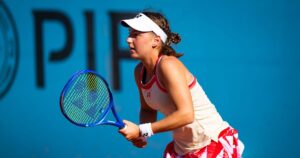
MADRID — Variety, undeniably, has been seeping into Aryna Sabalenka’s power game. It’s one of the leading reasons she ascended to the No. 1 position in the PIF WTA Rankings.
These subtle but increasingly significant additions — particularly, coming to net more often and hitting drop shots with increasing frequency — will be on display Friday here at the Mutua Madrid Open when she meets qualifier Anna Blinkova in a second-round match.
“I think maybe on clay it’s a bit easier because the game overall is a bit slower,” Sabalenka said Wednesday in her pre-tournament press conference. “You have extra time.”
And then a contrary thought occurred to her.
“I don’t know, at the same time it’s easier and harder because I have more time and I have more options in my head,” Sabalenka said, laughing, “and sometimes I get confused.”
Sabalenka, leading the rankings by more than 3,000 points and the 2025-specific Race to the WTA Finals by more than 800 points, is clearly the Hologic WTA Tour’s very best player at the moment. And yet, she’s willing to admit she hasn’t quite figured out how to incorporate diversity into an approach that once relied almost exclusively on brute force and brawn.
“It’s a learning process and I’m not afraid to make mistakes,” Sabalenka said. “I think with time I will learn how to make the right decisions. It’s going to benefit my game. I think on the clay court, it’s like a good practice with those shots.
“You just have to make sure you pick the right one at the right moment.”
Moving forward
Last fall at the WTA Finals in Riyadh, Sabalenka’s coach Anton Dubrov talked about the search for new weapons.
“We’re trying,” he told wtatennis.com, “to find somewhere we can be better.”
It’s been an ongoing effort.
Two years ago, double faults cast a huge shadow on Sabalenka’s season. She produced a staggering WTA Tour-high 428 in 2022 and, factoring in 249 aces, was minus-179 overall. Sabalenka added biomechanic specialist Gavin MacMillan to her team and the problem was solved.
In 2023, she hit 404 aces and 285 double faults for a remarkably improved plus-119 ratio. Perhaps not coincidentally, Sabalenka won her first Grand Slam singles title in Melbourne and has taken three of the past five majors played on hard courts.
And now, moving forward, there’s the current initiative: moving forward.
Dubrov has heard all the suggestions and has developed a pretty clever response.
“Everyone can say, `Oh, yeah, she’s got to finish on the net,’ ” Dubrov said. “That’s good advice, like, `Don’t do double faults.’ That’s also great advice.”
Far easier said than done.
“It’s got to be at the right time,” Dubrov said. “What is the structure of the point? Within your mind, you have to finish the point at net.”
Check out this chart, heading into the clay season, from Stats Perform:
Note the steady increase in Sabalenka’s net approaches. When those 2021-24 numbers were recited to him, Dubrov smiled, saying, “That’s a big jump.”
Since Sabalenka has played only 30 matches so far in 2025, it’s too early to pass any judgment for the current season. But in 2024, only three players — Tatjana Maria, Marta Kostyuk and Leylah Fernandez — had more successful approaches to the net. Other players who consistently go forward and win points at net are Elena Rybakina, Beatriz Haddad Maia, Jasmine Paolini and Coco Gauff.
Variety amplifies power
This forward-moving trend warms the heart of Martina Navratilova
The 18-time Grand Slam singles champion pioneered aggressive net play in women’s tennis. One of her pet peeves is when players don’t take advantage of their power and end points more quickly at net. Two of the players she’s cited have been Iga Swiatek and Sabalenka — the two top-ranked players for more than three years.
How important is it that Sabalenka has added this tool to her game?
“It’s huge,” Navratilova said, “because the margins are so small. By not moving forward you’re allowing the other player to get back into the rally. And then you have to start over. You are improving the odds of winning the point by moving forward and hitting the right shot — and, therefore, improving your odds of winning the match. Every little bit helps.
“Whether you make the shot or not — you’re trying. But moving forward or not, that’s a choice. Sabalenka’s volley has gotten better. She’s got more variety. It’s great to have that much power, but when you add variety to it — that power pays off even more.”
Jessica Pegula, who lost to Sabalenka in the Miami Open final, has noticed it, too.
“She’s moving a lot better, and I think being a little bit more creative on court,” Pegula said. “So all of a sudden, it’s not just her power, it’s a lot of these other things that she’s doing better that maybe used to be weaknesses. So I think she’s just all around has stepped up a lot of things.”
Like Sabalenka, Carolina Garcia is a power player who plays with a sometimes startling degree of aggression. She believes that advancements in fitness give today’s player the best court coverage the game has ever seen. Garcia said that the weight of shot from Sabalenka and herself often leads to shorter balls coming back — which creates the opening to close at net.
“It’s quite useful to go to the net because you are winning a lot of time on your opponent,” Garcia said. “And sometimes it’s a little bit easier because the ball will be a little higher to the net, so it’s easier to finish. Rather than when you have to let it bounce — and then the ball goes slowly again and you have to use the power and your risk gets a little bit more.
“So it’s always quite a good way to finish the point.”
Expect to see this strategy even more in the future
“It’s still in process,” Dubrov said. “I would say like 50, 60 percent. It’s not there yet. But if you can add, say five percent [more approaches] every half year, it’s huge.”
No mere drop in the bucket
After winning the title last year in Wuhan, her third in a row after a four-year absence, Sabalenka talked about her evolving game.
“I improved a lot,” Sabalenka said. “I can come to the net and I can finish point and then I can use my touch. I got some variation in my pocket. I just kept telling myself that if you’re not going to be able to hit the ball or slice, hit drop shot, come to the net.
“I was just reminding myself that I have a lot of weapons, not only hitting the ball.”
In practice, Sabalenka said, she could execute the drop shot. The issue was how to incorporate it into points. Last year, playing against Elina Svitolina in Rome — already feeling the effects of a shoulder injury that would force her to miss Wimbledon — she reached for it out of desperation.
“The only option for me was to finish the point as soon as possible,” Sabalenka said in Madrid. “I was like, `You know what, I’m going to go for the drop shots.’ I think the best training is training on the match. After that match I was like, `Oh, actually it’s working, probably we have to work on that shot more often.’
“Five years ago if someone will tell me I will finally learn how to do this shot, I’ll be like laughing. I don’t have touch. I’m so bad at it. Now I have this shot in my pocket.”
The element of surprise can be a game-changer in any sport, particularly at the elite level. In tennis, serving out wide when the ball is expected down the middle is a winning play. Or hitting crosscourt when the situation calls for down the line. So when Sabalenka’s potential power pushes opponents six or seven feet behind the baseline, she has another option.
“When I see the opponent is really way far behind,” Sabalenka said, “I’m like, `OK, I’ll just make them move.’ I’m really happy that finally, finally I learned this shot.
“I kind of have control, which is crazy to say, to be honest. Yeah, that’s just good to have, isn’t it for me? For me, not for my opponent.”
Source: https://www.wtatennis.com/news/4253308/sabalenka-s-next-power-move-adding-a-little-finesse



